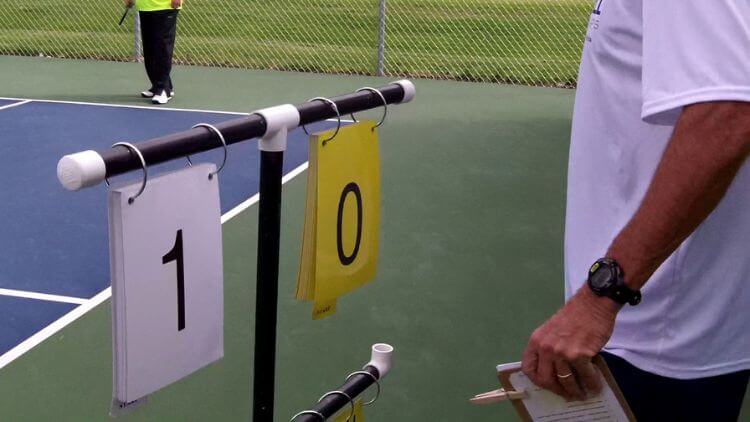Pickleball, a widely enjoyed paddle sport, delivers an exhilarating and dynamic gameplay experience. An essential element of the game lies in determining the number of points needed to secure victory. Pickleball is played to how many points to win pickleball? The scoring system in pickleball is thoughtfully crafted to uphold competitive balance while ensuring reasonable game durations. This article aims to delve into the various scoring formats employed in pickleball and analyze their influence on gameplay. By grasping the required point thresholds for winning, you can deepen your understanding of this exciting sport, enabling you to navigate its rules and strategies with greater proficiency.
What Score Do You Need to Win in Pickleball?
The standard goal in pickleball is to obtain a score of 11 and win by a margin of two points. As a result, if the score is deadlocked at 10 points each, the game will continue until one side manages to earn a two-point edge. The winning side will be the first to 11 points with a two-point advantage.
However, it is important to keep in mind that the precise winning point total might change based on elements like the difficulty of the game or the tournament’s regulations. Some games may have a larger winning point total, such 15 or 21, but still need a two-point advantage to win.
The fact that only the serving team may score in pickleball is a crucial component of the scoring system. The receiving team does not receive a point but does get the chance to serve if they effectively end a rally. When a serving team wins a rally, they are the only team to receive points for that rally.
Moreover, pickleball employs a “side out” rule to ensure fair play. This rule comes into effect when the serving team commits a fault, such as hitting the ball out of bounds, or loses a rally. In such cases, the serve is transferred to the opposing team, granting them the chance to accumulate points until the next side out occurs.

To summarize, the typical scoring goal in pickleball is to reach 11 points, with a requirement of a two-point lead for victory. However, this winning point total can vary depending on factors such as the level of play or specific tournament rules. Only the serving team can earn points, and the side-out rule is implemented when faults or lost rallies occur.
How to Call the Score in Pickleball?
In pickleball, calling the score is an essential aspect of the game to ensure that both teams are aware of the current score and can track their progress towards winning. Here is a step-by-step guide on how to call the score in pickleball:
Begin with the serving team’s score: Always announce the serving team’s score first, followed by the receiving team’s score. For instance, if the serving team has 3 points and the receiving team has 2 points, the score would be called as “3-2”.
Announce the server’s number: After stating the score, proceed to call out the number of the server. In doubles play, each player is assigned a number, and the server’s number is called to indicate who should serve the next point. For example, if the score is “3-2” and player 1 is serving, the score would be called as “3-2, 1st serve.”
Specify the serving side: Along with the server’s number, it’s important to indicate which side is serving. In pickleball, the serving team alternates sides after each point. So, if the serving team started on the right-hand side of the court and won the first point, the score would be called as “4-2, 1st serve, right side.”
Repeat the score after each point: As the game progresses, the score will change after each point. It is crucial to repeat the score after every point to ensure that both teams are aware of the current score.
By following these steps, you can effectively call the score in pickleball and maintain clear communication between the players regarding the game’s progress.
Clarify any disputes: If there is a dispute over the score or any other aspect of the game, it’s important to clarify the situation before continuing play. If necessary, call over a referee or another neutral party to help resolve the issue.
How to Keep Track of the Score?
Keeping track of the score in pickleball is crucial for fair play and maintaining a competitive environment. There are several methods for scorekeeping, including using a scorecard or a scoreboard. Here’s a step-by-step guide on how to effectively track the score in pickleball:
Determine the starting score: Before the game begins, agree on the starting score. In most pickleball games, a scoring system from 0 to 11 points is used, with the winning team needing to reach 11 points and lead by at least two points.
Use a scorecard: One common approach is to use a scorecard, which can be a physical or digital document. A scorecard typically consists of a table with columns labeled “Team A” and “Team B” and rows numbered from 0 to 11 (or more, depending on the scoring system). Each time a team scores a point, mark a tally or write the corresponding number in their respective column.
Assign serving team: At the beginning of the game, determine which team will serve first. The serving team’s score is always announced first, followed by the receiving team’s score.
Serve and earn points: As the game progresses, the serving team will continue to serve until a fault or a point is scored against them. If the serving team wins the rally, they earn a point and continue serving. If they lose the rally, the receiving team earns a point and takes over the serve.
Announce the score: After every point, it’s important to announce the updated score to all the players. This helps everyone stay informed and prevents confusion or disputes. For example, if Team A scores a point, you would say, “Team A: 3, Team B: 2.”
Alternate serve: In pickleball, the serving team alternates sides with each point scored, regardless of which team served. This ensures fairness and equal opportunities for both teams.
Keep track of side-switching: As the score progresses, remember to switch sides of the court when the sum of both teams’ scores is an odd number. For example, when the total score reaches 5 or 9, the teams switch sides of the court.

To attain the specified winning score, play must continue until one team does. Keep in mind that the winning team needs to have a two-point advantage or more. If the score is 10-9, for example, the team with 10 points must score another point to win.
Frequently Asked Questions
The average number of points in a pickleball match is 11. However, the victorious team must hold a two-point or greater advantage. As a result, if both teams score 11, the game goes on until one side has a two-point advantage.
Yes, the winning score can differ depending on the level of play, tournament rules, or recreational preferences. While 11 points is the most common winning score, some tournaments or recreational games may use a higher winning score, such as 15 or 21 points.
The standard scoring system in pickleball is based on a 0 to 11 point scale, with a two-point lead required to win. However, in some variations of the game, such as mini pickleball or recreational play, a shorter scoring system may be used, such as playing to 7 or 9 points.
Yes, according to the official rules of pickleball, a team must win by a margin of two points. This ensures a more decisive victory and prevents the game from extending indefinitely.
Generally, there is no specific time limit for pickleball games. The game continues until one team reaches the predetermined winning score, regardless of the duration of play. However, in some tournament settings, there may be time constraints or a maximum time limit imposed on matches.
Conclusion
How many points to win pickleball? The number of points required to win in pickleball is a fundamental element of the game. Whether it’s the classic 11-point format, the extended 15 or 21-point variations, or even variations specific to tournaments or recreational play, each format adds its own flavor to the game. The scoring format influences the pace, intensity, and strategic choices of players. By familiarizing yourself with the specific scoring rules before playing, you can fully enjoy the game and make strategic decisions that will bring you closer to victory. So, grab your paddles, understand the scoring rules, and step onto the court with confidence, knowing how many points you need to win pickleball.

